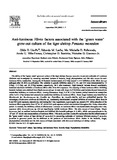Evaluation of dietary freeze-dried Chaetoceros calcitrans supplementation to control Vibrio harveyi infection on Penaeus monodon juvenile
- Global styles
- MLA
- Vancouver
- Elsevier - Harvard
- APA
- Help

View/
Date
2014Page views
5,352ASFA keyword
vibriosis 
diet
pathogenic bacteria
shrimp culture
fatty acids
feeding experiments
mariculture
antibiotics
feed composition
feeding
linolenic acid
immune system
lipids
survival
disease resistance
infectious diseases
aquaculture
plasma proteins
dietary supplements
colonies
polyunsaturated fatty acids
immunity
glucans

diet

pathogenic bacteria

shrimp culture

fatty acids

feeding experiments

mariculture

antibiotics

feed composition

feeding

linolenic acid

immune system

lipids

survival

disease resistance

infectious diseases

aquaculture

plasma proteins

dietary supplements

colonies

polyunsaturated fatty acids

immunity

glucans

AGROVOC keyword
Taxonomic term
Metadata
Show full item record
Share
Abstract
Effects of supplementation of diets with freeze-dried Chaetoceros calcitrans to control Vibrio harveyi infection are evaluated through immune responses, and disease resistance of juvenile Penaeus monodon. Total lipid and fatty acid profile of Chaetoceros calcitrans is also analyzed. A challenge infection with 107 cfu/mL concentration of Vibrio harveyi is intramuscularly injected to juvenile Penaeus monodon after 45 days of feeding of diets supplemented with 15 g/kg and 30 g/kg dried Chaetoceros calcitrans. The use of dried Chaetoceros calcitrans is compared with that of ß-1,3 glucan Curdlan, a commercial immune enhancer. Incorporation of 30 g/kg Chaetoceros calcitrans in the diet enhances the immune system of shrimp as effected by high prophenoloxidase activity and plasma protein concentration and is better compared to the commercially available Curdlan. Chaetoceros calcitrans also contains polyunsaturated fatty acids (PUFAs) such as linolenic acid and eicosapentanoic acid (EPA) which are responsible for its antibacterial action against Vibrio harveyi. All these biological activities of Chaetoceros calcitrans add up to increase resistance of the juvenile Penaeus monodon to vibriosis as shown by its high survival rate from the challenge infection with Vibrio harveyi. Therefore, it is worthwhile to use Chaetoceros calcitrans as supplementary feed. Its effect in increasing the immune competence coupled with its antibacterial action, make the shrimp resistant to luminous vibriosis that continues to affect the industry, thereby augmenting aquaculture production.
Keywords
Luminous vibriosis Chaetoceros calcitrans Vibrio harveyi Penaeid shrimp Immunostimulant Antibacterial activitySuggested Citation
Seraspe, E. B., Gabotero, S., de la Peña, M. R., Pahila, I. G., & Amar, E. (2014). Evaluation of dietary freeze-dried Chaetoceros calcitrans supplementation to control Vibrio harveyi infection on Penaeus monodon juvenile. Aquaculture , 432, 212-216. https://doi.org/10.1016/j.aquaculture.2014.04.040
Type
ArticleISSN
0044-8486Collections
- Journal Articles [1258]
Related items
Showing items related by title, author, creator and subject.
-
Antibacterial metabolites in the microbial and phytoplankton flora of the "green water" culture of shrimp (Penaeus monodon): Part I. Anti-luminous vibrio factors associated with the "green water" grow-out culture of shrimp (Penaeus monodon)
Lio-Po, Gilda D.; Leaño, Eduardo M.; Peñaranda, Ma. Michelle D.; Franco, Annie; Sombito, Christopher D.; Guanzon Jr., Nicholas G. (Aquaculture Department, Southeast Asian Fisheries Development Center, 2005-03)The ability of the “green water” grow-out culture of black tiger shrimp (Penaeus monodon) to prevent outbreaks of luminous vibriosis was investigated by screening associated isolates of bacteria, fungi, phytoplankton and ... -
Anti-luminous Vibrio factors associated with the ‘green water’ grow-out culture of the tiger shrimp Penaeus monodon
Lio-Po, Gilda D.; Leaño, Eduardo M.; Peñaranda, Ma. Michelle D.; Villa-Franco, Annie U.; Sombito, Christopher D.; Guanzon, Nicholas G., Jr. (Elsevier, 2005)The ability of the “green water” grow-out culture of the tiger shrimp Penaeus monodon to prevent outbreaks of Luminous Vibriosis was investigated by screening associated isolates of bacteria, fungi, phytoplankton and fish ... -
Antibacterial metabolites in the microbial and phytoplankton flora of the "green water" culture of shrimp (Penaeus monodon): Part III. Biocontrol of luminous Vibrio in the grow-out culture of shrimp (Penaeus monodon)
Lio-Po, Gilda D.; Franco, Annie (Aquaculture Department, Southeast Asian Fisheries Development Center, 2005-03)The development of an “indigenous probiotic” for the grow-out culture of black tiger shrimp (Penaeus monodon) was pursued in this study. Five of nine bacterial isolates with demonstrated anti-luminous Vibrio metabolites ...





